




Norman - East
801 12th Ave. NE
Norman, OK 73071 (405) 579-7000
Norman - Hwy 9 4925 SE 44th St.
Norman, OK 73072 (405) 579-7000
Norman - North West 570 24th Ave. NW
Norman, OK 73069 (405) 579-7000













































Exclusive Facility Access:
Two indoor 25-yard pools
Eight basketball courts
Twelve volleyball courts
Eighteen indoor pickleball courts
Outdoor lighted amenities: two sand
Volleyball courts and six pickleball courts
Leagues:
Basketball for adults and youth
Adult and youth indoor volleyball
Coming soon, sand volleyball!


Our summer camps are the perfect way to stay active and have fun, featuring top-notch instruction in basketball, volleyball, and football from only the best coaches around. Whether you're honing your skills or trying something new, there's something for every athlete.







SUMMER BREEZE CONCERT SERIES 13 HANDMADE MOMENTS
7:30PM • LIONS PARK NORMANDEPOT.ORG

A Look Inside Dr. Migliorino’s Vision for Norman Public Schools
Norman Public Schools Superintendent Dr. Nick Migliorino was named Oklahoma Association of School Administrators’ 2025 District 7 Superintendent of the Year, marking the second time he has earned this honor.
The first was in 2022.
Migliorino said the award “represents the collective effort of the Norman Public Schools community.”
“It reinforces that the work we’re doing in Norman,” he explained. “Any recognition I receive is really a celebration of our people, our teachers, principals, support staff and district leaders who work every day to help students reach their full potential.”
In honor of this recognition, we asked Dr. Migliorino a few questions to highlight the work going on at NPS.
WHAT SPECIFIC PROGRAMS OR INITIATIVES ARE YOU MOST PROUD OF?
I’m most proud of the strategic systems we’ve built that truly align with our values. Our comprehensive strategic plan is not just a document, it’s a living guide that helps us focus on student success, staff
support and community engagement.
I’m also proud of the work we’ve done around student well-being. We’ve expanded access to mental health services, increased safety measures and created more inclusive learning environments. Our communication has become more transparent and responsive, and our emphasis on relationships has helped build trust districtwide. All of this comes back to one core belief: every student deserves to feel safe, supported and seen.
Motivation starts with purpose. I work hard to make sure every team member sees how their role contributes to student success. That means showing up, listening closely and recognizing the good work happening across the district.
We hold regular advisory meetings where voices from all parts of the system help shape direction. Those conversations build ownership and energy, and they remind us we’re all part of something bigger.
BY: LINDSAY CUOMO
FACED AS SUPERINTENDENT, AND HOW DID YOU OVERCOME THEM?
Like many superintendents, I’ve navigated major challenges, from responding to a global pandemic to leading through rapid changes in education and policy. But the biggest challenge is often staying focused on what matters most amid constant demands. I’ve overcome that by building a strong, collaborative team and keeping our strategic goals front and center.
I also rely on relationships, listening to our community, supporting our staff and being transparent about what we’re facing. Challenges will always come, but staying grounded in our mission and values has helped us move forward with clarity and confidence.
Our goals for the coming year are centered on growth, connection and continuous improvement. We want to deepen our focus on student learning and well-being, strengthen our recruitment and retention of high-quality staff and continue building strong partnerships with families and the community.
At the core, our goal is to keep preparing and inspiring every student to achieve their full potential, and to do so in a way that reflects the integrity, inclusiveness, collaboration and optimism that define our district. – BSM




tarting next school year, Norman Public Schools will have a Spanish Language Academy at Truman Primary and Truman Elementary schools. The program is open to all elementary-aged students, with enrollment preference given to Norman residents.
Applications for the academy were accepted this spring for students in pre-kindergarten through fifth grade.
According to Janet Gorton, director of world languages and English learners for the district, the concept for a language immersion program has been “percolating for a number of years.”
“Norman Public Schools is always looking for new opportunities for our students,” Gorton shared. “We know from research that language learning is most impactful in our youngest learners because of how adaptable they are.”
In addition to acquiring a second language, students will benefit from enhanced cognitive development, Gorton said.
“Learning a new language increases problem solving and critical thinking skills because you are developing new pathways in the brain,” she said. “Language learning is such an exciting thing. You never know where it will take you.”
Ann Rosales, assistant superintendent for educational services, said the academy supports the district’s broader mission.
“We want to think creatively with how we prepare our future career force, and a rich language program is one way we can do that,” she explained.
Since the academy must also align with state academic standards, curriculum will be presented in both Spanish and English. Gorton said that the academy’s goals for the first year are to primarily focus on listening and speaking skills.
PreK through second grade students will receive reading and language arts instruction in English and instruction in other subjects will be taught using a mix of English and Spanish. For third through fifth grade students, the curriculum will be taught in both Spanish and English.
“More instruction will happen in Spanish as students grown in their skills,” Rosales added.
Gorton said the new academy has been well received by the community.
“Parents are appreciative and enthusiastic about this program,” she said. “Being in Norman, we are a community that really embraces different learning opportunities. We are excited to grow this over time, creating collaborative relationships within our community to be as impactful as we can be.”
To learn more about the academy, visit normanpublicschools.org/page/spanish-language-academy.– BSM




















Anew twist on a long-standing fundraiser will bring food lovers and community supporters together for a good cause this fall. Noshville Norman, a freshly themed event benefiting Big Brothers Big Sisters of Oklahoma, is set for Sept. 12.
The country-chic celebration is a reimagining of Taste of Norman, a beloved gala known for its sampling of local restaurant fare. The event later evolved into Big Movie Night during the COVID-19 pandemic to allow for social distancing. This year’s theme aims to combine the best of both experiences with a renewed energy and mission.
“This event is something new and unique while also maintaining tradition. We are so grateful to our event chairs, sponsors and the public for helping directly support our mission, which is to create and support one-toone mentoring relationships that ignite the power and promise of youth,” said Michael Stuemky, Norman area
director for Big Brothers Big Sisters of Oklahoma.
Dozens of local restaurants have applied to participate. Attendees can expect tapas-style servings with bite-size portions of diverse dishes.
“Restaurants showcase their best offerings, including test items looking for feedback, so that’s an exciting element of it too,” said Stuemky. “We vet the menu and make sure there’s not too much of any one thing.”
Joey Wishnuck, local developer, builder and investor, and Elizabeth Hurley, area real estate agent, are this year’s chairs.
“Joey and Elizabeth bring important aspects of the Moore-Norman community together. They got involved because they see what we do and why we do it, having seen and felt the impact of the organization,” said Stuemky.
Event Chair: Joey Wishnuck
This year’s funding goal is $130,000, raised through sponsor tables, silent and live auction, individual giving and ticket sales.
“Funds help with staffing, match support, the maintenance of our beautiful facility where participants can meet, background checks and more,” said Stuemky.
Big Brothers Big Sisters of Oklahoma started its Oklahoma City chapter in 1955, and Norman’s site soon followed in 1969. Fundraiser galas have been part of the organization’s tradition for decades.
Developing lifelong supportive friendships with a role model helps influence positive results, which is the program’s premise. Young professionals, college students, parents, retirees and other safe adults can make a tremendous difference in the life of a child.
“Going out and finding ‘bigs’ in the community, pairing them with kids who need that extra pillar of support, completing a significant interview process, hosting mentorship training for developmental psychology and more is a huge part of the process,” said Stuemky.
“We are extremely intentional about how matches are made. Our growth in need has been significant but we have that community partnership to support the process for long-term, effective outcomes.”
Event Chair: Elizabeth Hurley
So far in 2025, the number of mentorship matches made has already exceeded that of any year since the chapter’s founding, more than 300.
Safety is the organization’s first priority, with one of the criteria for how young a child can be paired with a mentor being their ability to express themselves, typically ages 6 and up. A common misconception is that Big Brothers Big Sisters focuses on tutoring. Although academic assistance can be part of the activities pursued, life skills and sample tasks like running errands are an important part of helping children learn valuable lessons.
“From going to the library together, to throwing a Frisbee or just sharing a favorite sport, it’s literally a friend with life experience to coach the entire way,” said Stuemky. “That modeling piece is individual and unique to every single match. It’s getting to do something for a child so many adults wish had been done for them.”
A limited number of tickets will be available for Noshville Norman. Find more information at bigoklahoma. org/noshvillenorman. – BSM











For Meals on Wheels of Norman, Inc., what they do means more than a meal.
Since 1972, the organization has been a key support system in the Norman community, delivering nutritious noontime meals to the ill, disabled and elderly. Currently, Meals on Wheels serves about 300 people per day, Monday through Friday.
Often, this meal delivery is the only outside contact the clients may have each day, and the volunteers become like extended family to many of these seniors, explained Summer McGuire, executive director.
“The volunteers are all amazing people, and some of them have been delivering for 20 or 30 years,” McGuire said. “Their dedication is amazing to me, and the clients are truly a part of their lives. A lot of the clients don’t leave their houses, so they really don’t have the opportunity to socialize. I think that’s probably my favorite part is the relationship that’s created between the volunteers and the client.”
Volunteers are key to the success of the nonprofit, and over 18,000 volunteer hours were recorded in 2024. McGuire said interested people can fill out the volunteer inquiry form on mealsonwheelsnorman.com to be contacted by a staff member. They can also call the office at 405-321-7272 to learn more about opportunities on the Meals on Wheels Facebook (Meals on Wheels of Norman, Inc.) and Instagram (@mealsonwheelsnorman) pages.
There are multiple ways in which people can volunteer with Meals on Wheels. One is to deliver a route, especially in the summer when regular volunteers go on vacation. Each week, about 160 people deliver meals.
Another avenue is through the annual Meals on Wheels Golf Scramble, scheduled for Monday, July 14 at The Trails Golf Club. In December, the nonprofit holds a poinsettia sale and utilizes volunteers to deliver those purchases. Additionally, people can visit the Meals on Wheels office to assemble shelf-stable meals that are distributed during holidays and weekends.
The Meals on Wheels staff includes three full-time and two part-time staff members. McGuire said they are focused on enhancing the lives of their clients, volunteers and donors, a goal of hers when she stepped into her current role.
McGuire joined the organization in 2003 and has been executive director since March 2024. She grew up in Norman and attended the University of Oklahoma for both a bachelor’s degree in journalism and public relations and a master’s degree in human relations.
Before coming to Meals on Wheels, McGuire was working in Midwest City but living in Norman while attending graduate school. A family friend who was
on the board of directors at the time informed her that the organization was seeking someone to lead its fundraising efforts, and she decided to apply.
“I never thought I’d be in the nonprofit sector, but I fell in love with it,” McGuire shared. “It’s so rewarding knowing what you’re doing in the office is really making an impact on someone else’s life and allowing them to stay in their home for as long as possible.”
McGuire said it has been great to be part of the community that helped raise her. Norman has also been a great place to raise her two sons, and as a huge OU fan, she enjoys game days and going to athletic events. McGuire added that it is special to be part of an organization like Meals on Wheels, which is deeply loved in the community.
“We were created as a community organization, and that’s one of the things we want to stay,” McGuire stated. “If you’re 16 and have a valid driver’s license, you can volunteer. We have college students during the school year who volunteer. We have mothers who bring their young children to volunteer. We have companies that volunteer. We have retired individuals who volunteer. We really couldn’t do without our volunteers, and they’re the true MVPs of the organization because they make it happen.”– BSM









SEASON & DAY PASSES • SWIM LESSONS • AQUATIC FITNESS
LAZY RIVER • SPLASH PAD • ZERO DEPTH ENTRY • LAP POOL
DIVING BOARDS • CLIMBING WALL • WATER SLIDES • TODDLER AREA
MOVIE NIGHTS • ADULT NIGHTS • SPECIAL EVENTS • FACILITY RENTALS • CAMPS

BY: CHRIS PLANK
As the ever-changing landscape of college sports continues to evolve, the University of Oklahoma revolutionized its football operations with the development of a true front office, sending shockwaves through the college football world with the hiring of Jim Nagy as the program’s general manager. While the role of the general manager varies for each school and is somewhat fluid in its responsibilities, Nagy has embraced the unknown and, in doing so, has built an impressive personnel department prepared to help Sooner football thrive in a new era of college football.
“The word I keep using is energizing,” Nagy said of his new role. “I never really had plans to work at the college level. So, all this is new… It’s just too good of an opportunity. Just getting here and developing relationships and meeting people and then trying to get a process in place… It’s been a lot of fun.”
Nagy comes to Oklahoma after reinvigorating the Senior Bowl. Since 2018, Nagy has served as the executive director of the Senior Bowl, where he was responsible for the identification, evaluation, recruitment, and selection of the top NFL prospects to be invited to the game. In his role, he cultivated relationships across college football, the agent community and all 32 NFL front offices. Over the past five game cycles, the Senior Bowl has consistently produced more than 100 drafted players annually, representing over 40 percent of those draft classes. Last year, the Senior Bowl had a record 110 total selections, including 45 of the top 100 players and 10 first-round picks.
The Senior Bowl helped prepare Nagy in a unique way for the opportunity at Oklahoma.
“I think the biggest thing there is the relationships with the agent groups. Not all these high school guys are represented by the same groups of people that are representing NFL guys,” Nagy said. “But more and more, that’s being the case. I think a lot of the established NFL agent types are putting their toes in here a little bit to see if they want to get in the college world, and now they feel like it’s almost a necessity if they want a chance to get them four years down the road.”
Prior to his role with the Senior Bowl, Nagy spent two decades in various scouting capacities with the Seattle Seahawks, Kansas City Chiefs, New England Patriots and the Washington Redskins. During his 18 years in NFL front offices, his teams played in six Super Bowls and won four Lombardi Trophies. Now, Nagy is bringing that experience and skill to Oklahoma to find the best players possible.
The love of football has been a constant presence in Nagy’s life.
“I grew up in a house with a dad as a coach, so from my earliest memories, I was a little kid around the game,” Nagy said. “Then, he walked away from coaching and teaching and moved us to a new city. And just by chance, I became best friends with the kid whose dad was the head football coach at that school.
“I was the waterboy from the time I was little. And then you get up to elementary school, and I’m fixing helmets. Then playing the game. It’s just always something that has been a part big part of my life.”

Nagy’s name has been linked to general manager positions across the NFL for years. During this off-season, he interviewed for the New York Jets and was a rumored candidate for several other openings. A respected name in the industry, many felt the next step in his career was the NFL, but Nagy chose Oklahoma and the college ranks because of the overall vision for the role.
“Other schools have been throwing that label around quite a bit over the last couple of years. I think it means something different everywhere,” Nagy said of his title. “When I came to Oklahoma and really laid out the vision with Randall Stephenson and Joe Castiglione, it made a lot of sense.
“I’m a big believer in my profession. I think we all are. I think we all love what we do. I love scouting… I believe in the power of it. I felt like if I was able to put a staff together, which now I have, we could make a real impact. You can win at a high level at OU, and I want to win. I wasn’t going to go somewhere where they didn’t have the resources, and I know I have that at Oklahoma.”
Nagy will lead OU’s roster management and talent acquisition, including player recruitment, evaluation, retention and compensation as part of his duties. He will also manage the impact of rules governing Name, Image and Likeness, the transfer portal process, revenue-share allocation, scholarship limits and eligibility requirements.
The new model is intended to meet the emerging challenges of college football and mirrors many aspects of professional sports teams. It allows the general manager and head football coach to work sideby-side in partnership, each focusing on a specific area of expertise. And in the eyes of Jim Nagy, take a major load off the shoulders of the coaches.
“I think the key thing for us is having manpower to take a big heavy lift off the coaches. (And) you get levels of cross-check in your evaluations,” Nagy said. “Historically in college football, the position coaches have had full autonomy to go recruit who they want.
Then the head coach makes the final call. Well, that’s just really one voice…that’s not the way to do it.
“Going back maybe 10 to 15 years ago in the NFL, a lot of NFL systems were set up that way. Now, by the time you get to draft day in the NFL, you’ve had eight or nine sets of eyes on a player. That cuts down on your margin for error. We’re going to do the same thing here.”
As Nagy built his scouting staff, he was intentional in finding a broad spectrum of experience. From the NFL to college and even the agent world, the group is littered with football experience from all walks of scouting and talent evaluation.
“The chemistry has been great,” Nagy said of his scouting staff. “We were all displaced for a little bit together. There was a lot of construction going on upstairs, so we were all in the dining hall officing and working together for a while.”
Including Nagy, the seven-person staff has 60 years of combined experience in collegiate football and 67 years of NFL experience. Collectively, the teams they were associated with participated in 36 bowl games, nine Super Bowls, and won five Super Bowl titles.
“To see the synergy happen between the coaching staff and the scouting staff has been incredible,” Nagy said. “The most important relationship in any NFL building is the cohesion between the head coach and the general manager, having that shared vision. And in Brent, I have that.”
Now the challenge becomes finding the best players who fit what Oklahoma wants and can help bring the Sooners back to the top of college football.
As Nagy assembled his staff, he simultaneously worked to address current roster needs. His evaluations began with an unvarnished assessment of the team, ensuring that any bias was removed, while working closely with coaches to understand the less tangible dynamics of the roster. The bottom line remains centered on winning and fielding the best team possible in 2025 and beyond.
“The goal for me was to come in and let my own eyes do the work first and not be biased,” Nagy said of his first impression of the Sooner roster. “Where is your room right now in terms of the leadership and all the things that are really, really important. That’s been key to learning this football team. But as I said at the opening press conference, I owe that to these players to learn them first.”
That evaluation began with the quarterback position and the new Sooner signal caller, John Mateer. While Nagy was not yet the Sooner’s general manager when Mateer moved to Norman, he quickly bought into what Mateer could mean to this program.
“I feel like everything starts with John Matter. Mateer hit the ground running,” Nagy said. “The biggest thing with John is just seeing what he’s been like in this building daily and his ability to connect with his teammates.
“Then you talk about a couple of young offensive linemen, a portal offensive lineman, huge upgrades up front… Jaydn Ott in the backfield. We’ve got some receivers who I think most of the fans don’t know, that I think they’ll get to know quickly. And then, Coach Venables’ defense is his defense.”
Cal transfer running back Jaydn Ott has been the biggest addition of the Nagy era to date and has the potential to be incredibly impactful. Ott, one of the top overall playmakers returning to college football, has produced 3,460 all-purpose yards over the past three seasons, the third most among all returning FBS running backs.
“At the Senior Bowl, he was at the top of the board last year for us with Omarion Hampton and Ashton Jeanty,” Nagy said. “Jaydn had a high ankle issue last year and never really got right or he’d be in the league right now. What we saw was a dynamic playmaker who can score from anywhere on the field and can create plays. It was hard to find those guys.”
Nagy’s approach is not just about immediate results. It’s about creating a system that can sustain success. By building a front office that is deliberate and methodical in its talent evaluation, Nagy is ensuring that Oklahoma remains competitive for years to come. The cohesion between the scouting staff and the coaching staff is a key element of this strategy, as is the program’s ability to adapt and evolve.
“We’re doing this differently than everyone else,” Nagy said, pointing to the streamlined processes that reduce wasted time and focus on evaluating players who fit the program’s vision. This innovative approach is designed to position Oklahoma as a leader in college football, not just on the field but also in how it operates behind the scenes.
With Nagy at the helm, Oklahoma football is undergoing a transformation that prioritizes synergy, expertise and innovation. By aligning the efforts of the front office and coaching staff, the Sooners are building a foundation for both immediate success and longterm dominance. – BSM











The University of Oklahoma women’s rowing team under Sarah Trowbridge has been striving to be the best in college rowing in a region that is not synonymous with the sport itself. But thanks to a renewed investment from the City of Oklahoma City and a consistent commitment from the university, Oklahoma rowing is positioning itself to be among the elite in the sport for years to come.
“This is not a place that has decades of rowing, but the fact that the university has embraced it, and the high quality of support that they give all their student athletes gives me confidence,” Trowbridge said of the program’s vision. “Sooner Nation understands that it’s the marathon vision.
“It’s going to be tough. It’s going to be a climb. We’re going up against the top teams in the country, but we’re not afraid of hard work, and we’re not afraid of hard work year after year.”
The University of Oklahoma’s rowing team was founded to bring athletic diversity to the university’s sports programs. Over the years, the team has demonstrated steady progress, overcoming challenges related to geography and rowing culture in the Southern Plains. Oklahoma’s commitment to the sport has been reflect-
ed in the construction of facilities, the recruitment of athletes and partnerships with the local community. Thanks to the city’s support and a renewed investment in rowing, the program has attracted talented athletes and coaches who have elevated the team’s performance. The program continues to grow, seeking to become a beacon of excellence in college rowing for years to come.
The hiring of Trowbridge in 2022 was one of the biggest commitments to the program’s long-term vision. With a wealth of experience as an elite rower and coach, Trowbridge has brought passion to the program. As a former Olympian, she understands the discipline and strategy required to succeed at the highest levels of the sport.
“I’m from the Washington DC area, and there we have a beautiful river where you would see rowing boats all the time, but I didn’t start rowing until I was a senior in high school,” Trowbridge said of her history with the sport. “I think rowing is one of those amazing sports where you are better if you’ve done a lot of other sports. You have to be tall, you have to be strong. The boats are really heavy.
“Rowing has been able to give me opportunities to travel all over the country and all over the world.”
Trowbridge’s husband worked as a coach in the Olympic training center in Oklahoma City.
“He really loved living in Oklahoma, and so when I got the call at first, I wasn’t looking to move on,” she said. “I was really happy with what I was doing, but coming down here, I got to see what the athletic department wants to do and the authenticity behind the initiatives. You feel like they want the best thing for the athletes. That resonated with me.”
Trowbridge’s leadership is a cornerstone of the program’s growing reputation. She helped spearhead the move into the SEC, where the number of programs might not be significant, but the commitment is strong.
“The SEC is a small rowing conference, but we have the top team in the country and maybe the second-best team as well,” Trowbridge said of the new conference. “We have the most competitive conference. You’re comparing yourself against the well-established number one team, Texas, who has won three national championships over the last four years. That’s what OU is about. We all want to make a new level for the sport. Let’s make this the benchmark… Let’s make this the new standard.”
The biggest commitment to the rowing program was the development of the on-campus training center. The 24,000-square-foot OU Rowing Training Center is one of the finest on-campus rowing facilities in the country. It houses a state-of-the-art, 16-seat “moving water” rowing tank that simulates on-the-water training indoors. The facility also features a 2,740-square-foot workout area, sports medicine and hydrotherapy areas, locker and team rooms and meeting spaces.
When not on the water at Oklahoma City’s Boathouse District on the Oklahoma River, the facility provides the team with a place to train and allows student-athletes to improve in an individual setting away from the water. It’s made a major difference in the training of student-athletes and, in turn, the success of the program.
“I think we are so lucky to have that place, because our sport takes place at a boathouse, and the river here is up in the city,” Trowbridge said of the on-campus home. “That has helped our younger or newer athletes get skill in the middle of winter, when everyone is not on the water. It’s a nice home base for the athletes.”
Among the many challenges that OU Rowing faces is finding the best potential athletes. For Trowbridge, knowing that the best rowers usually start in another sport, the recruiting never stops.
“You’re at the airport... You’re at the grocery store… I’m at Sprouts, and I’m checking out an athlete. What sport do you play? Hey… do you play a sport at the university? No? Would you like to?” Trowbridge said of her never-ending recruiting. “If you’re a rower, you most likely have gone up to someone. Have you ever thought about rowing? You can join our program. It is a lot of work, but you can compete at the highest level. You can become a Sooner.”
The University of Oklahoma’s rowing program is poised for an exciting future, marked by ambitious goals and solid investments by Oklahoma City and the University of Oklahoma. With strong leadership, cutting-edge facilities and a clear commitment to raising the bar, the University of Oklahoma rowing program is set to redefine collegiate rowing and inspire a new generation of athletes.– BSM
BY: CHRIS PLANK




At Armstrong Bank, your business isn’t just business to us. It’s personal. We’re invested in your success. Our friendly, knowledgeable bankers are ready to build a relationship that lasts, and our suite of products and services are designed with your convenience in mind. You deserve a strong financial partner by your side, and that’s exactly what you get at Armstrong Bank.

It’s been quite the journey for Norman native and Cubs pitcher Cade Horton.
Cade was a two-sport star at Norman High School and eventually committed to the University of Oklahoma for football and baseball. He was the starting quarterback for the Tigers and a pivotal right-handed arm on the baseball team.
Cade was rated as No. 2 overall player in Oklahoma his senior year and ranked as 14th overall by Prep Baseball Report. Despite being a force on the mound, he was an outstanding quarterback and he loved Norman High.
During his time at the University of Oklahoma, Cade developed into one of the best arms in the country. He was a critical part in the unforgettable run by the Sooners in 2022, when they made it to the College World Series Championship Series.
Cade’s mom, Cari Horton, cherished that moment seeing her son on the big stage.
“The bigger the stage and the brighter the lights have always brought out the best in Cade. The CWS gave him the opportunity for teams to get a few more looks at him, but as far as the stage, I can say with confidence God just created him for it,” Cari Horton said.
Cade had the privilege to learn behind one of the brightest pitching minds in college baseball. Sooners Head Coach Skip Johnson was a big piece in developing Horton into an elite arm. Cade’s father, Mike Horton, enjoyed having his kid under Johnson throughout his collegiate career.
“Skip is one of a handful of mentors Cade has had in his life that helped him get to where he is now,” Mike Horton said. “He did so much for Cade not only in baseball but developing him as a young man. He’s an incredible coach and mentor.
“Cade actually bought a house close to Norman to be able to work out at OU and still be under Skip’s direction.”
After the incredible 2022 run, Cade would have his dreams come true, getting drafted No. 7 overall to the Chicago Cubs. It was a special moment for the Horton household to see Cade’s work ethic pay off.
“We always told our kids they are the authors of their lives, nothing is for free. If you want to work for it, whatever your dream is go chase it. So Cade, like the rest, had a dream and worked to achieve it,” Cari said.
Cade started his professional career in Double-A for the Tennessee Smokies and then made his way up to Triple-A playing for the Iowa Cubs. After climbing the ladder in professional baseball, he got the special call in May.
After finding out he was getting the call-up to the big leagues, he Facetimed both of his parents to share the special news.
“It was very emotional,” Mike said. “We had been anticipating it, but nothing really prepares you as parents when it happens. I was thrilled for him for that dream to finally come true.”
“Mike and I (were) on the phone heading home after work, and we get a Facetime notice from Cade. We pretty much knew it was happening,” Cari said. “We let him get out the words and then we both just lost it. The dream your child has had since he could talk was coming true. It was very surreal.”
Cade made his MLB debut on May 10 against the Mets in four innings of relief work. He struck out five batters and earned the win. After that performance, Cade would make his first career start in the bigs the next week, getting the win over the White Sox with five innings and two strikeouts.
Athleticism stands out with Cade being a two-sport athlete, so where does he get that from?
“I always tell people to take one look at me, and can’t they tell where it came from?! In all honesty, I take credit for the tall genes although they clearly skipped me,” Cari said, jokingly.
“We have five children - a doctor, rancher, pro athlete, one studying for the MCAT and a fireman. We are neither smart nor athletic, tough to figure out how we are blessed with the kids we have,” Mike said.– BSM

BY:






















Teacher Dustin Bennett was able to take his students’ project to new heights this summer. Bennett, an engineering instructor with Moore Norman Technology Center, was one of eight teachers nationwide to participate in the Space for Teachers program that gives educators the opportunity to conduct student-designed experiments in microgravity aboard a specially modified aircraft.
During the flight, Bennett was able to test a device that his high school students at the technology center
designed to capture micro debris particles in space. Bennett took flight in May onboard the aircraft that performed a series of 30 parabolic maneuvers, achieving approximately 11 minutes of weightlessness, according to a news release about the program.
“It’s just amazing — a once-in-a-lifetime experience,” Bennett said about the opportunity.
Bennett said getting to test his students’ project was exciting, as was sharing stories about the experience with them. He said he also hopes it might serve as
an inspiration to students who are interested in the science and technology fields.
“I really want my students to see the opportunities that are out there,” he said.
One of the goals of the Space for Teachers program is to help enhance students’ skills in prototyping, data collection and technical communication, which are key competencies in careers in science, technology, engineering and mathematics.
Bennett was selected for the program and began training last year. This past academic year, his students began working on the project, developing an origami-inspired space debris capture device.
Part of the process also included collaboration with engineers from Space Forge, an aerospace manufacturing company. The student project was inspired by one of the company’s products, so students could see real-world applications, Bennett said.
As his students spoke to the Space Forge engineering team, “they discovered that our challenges mirrored the challenges that Space Forge was facing,” Bennett said. “And amazingly, the students’ solutions
BY: SHARLA BARDIN
also mirrored the solutions being developed by Space Forge. As the students were struggling through the process, I saw the interaction with Space Forge as such a boost to their motivation and determination.”
Bennett said one of the reasons for the focus on capturing space debris is how small objects, like paint flecks or small screws, traveling at high speeds can cause damage to spacecraft.
Bennett said after the flight, he was able to come back to the classroom and show students videos of the experience and talk about what did and didn’t work with the device. That also offered a learning experience so students could talk about what to do when you encounter obstacles in a project and how to move forward.
Bennett hopes that the project showed students the experiences and careers that are available to them if they want to further explore jobs in aerospace and engineering.
“I want them to realize they can do it,” he said. “There are plenty of opportunities out there for them.”– BSM



As we celebrate the Fourth of July, our thoughts often turn to the Revolutionary War, fireworks and the enduring ideals of liberty and democracy. Yet beneath the historical symbols lies another powerful force that has shaped and sustained our nation’s independence: business. From the earliest days of the republic to today’s global economy, business has been an essential driver of American strength, resilience and freedom.
When the Founding Fathers declared independence in 1776, it wasn’t just a political revolution—it was an economic one. Colonists were frustrated by British trade restrictions, taxes and monopolies that stifled local enterprise. The Boston Tea Party wasn’t just a protest against taxation without representation; it was also a reaction to the East India Company’s monopoly over American commerce. In many ways, the birth of the United States was fueled by a desire for economic self-determination.
Fast forward nearly 250 years, and business remains a cornerstone of our national autonomy. A strong, dynamic economy gives the U.S. the ability to make independent decisions on the world stage. Economic strength supports our military, funds infrastructure and innovation, and provides the stability that sustains our democratic institutions. Without a vibrant business sector, the promises of the Declaration of Independence—life, liberty and the pursuit of happiness— would be far harder to fulfill.
Small businesses, in particular, represent the spirit of American independence. Owned and operated by individuals and families, they embody values like hard work, risk-taking and self-reliance. These businesses aren’t just economic units, they’re pillars of communities, creating jobs and opportunities where people live. Every entrepreneur who opens a neighborhood coffee shop, launches a tech startup or runs a one-of-a-kind boutique carries forward the legacy of American independence by forging their own path and contributing to the greater good.
But big business plays a vital role as well. Large corporations drive innovation, create millions of jobs and compete on a global scale. Their success helps keep America competitive, attracts investment and fuels the tax base that funds public services and national defense. When managed responsibly, the scale and reach of big business can amplify the nation’s strength.
This Independence Day, as we enjoy parades and fireworks, let’s also remember the less visible but no less vital role business plays in sustaining our freedom. The economy is not just a backdrop to American life; it is a force that shapes our choices, strengthens our sovereignty, and ensures that independence is not merely a historic event, but a living reality. In every town, on every workshop floor and in every design lab, the American business spirit continues to power the ideals first declared on July 4, 1776. That is something worth celebrating.
.
Norman Regional is at the heart of advanced cardiovascular care in southern Oklahoma. We proudly o er $50 heart scans with no referral required, plus a full range of heart services, including ablations, pacemakers and treatment for AFIB. We deliver award-winning care. With a cardiac catheterization lab and life-saving expertise nearby you’ll find compassionate, leading-edge heart care right down the road.

Bruce Cannon, MD
Cardiothoracic Surgeon
More than 30 years of experience
Schedule your $50 heart scan today.
Gardening is a fulfilling hobby, but it can be expensive. The good news is a flourishing garden doesn’t have to come with a hefty price tag. Here’s how to cultivate a beautiful, vibrant garden without breaking the budget.
It’s tempting to fill your garden with everything that catches your eye, but it’s best to start small. Do some research to learn which low-maintenance plants can thrive in your local climate and soil conditions. Then, create a small garden plan that will help you avoid impulse buys. Once you’ve mastered your small garden, move on to something bigger until you have the garden of your dreams.
Watching a flower or vegetable grow from seed to blossom is a uniquely rewarding experience. As a bonus, seeds are generally far more affordable than seedlings. Get your seeds at community library and gardening club seed swaps, where you can exchange seeds with fellow gardeners at no cost. Alternatively, you can ask your friends or neighbors if they have plants to share.
Instead of purchasing expensive pots or planters, repurpose items you already have. With some creativity, old buckets, crates and coffee cans can make excellent planters. Drill drainage holes in the bottom and decorate them to suit your style.
Purchase tools at the dollar store
There’s no need to blow big bucks on gardening tools like trowels and watering cans. You’ll find all kinds of gardening tools that do the job just fine at your local dollar store for half the cost.

Skip store-bought fertilizers by starting your own compost pile. Kitchen scraps, like fruit and vegetable peels, coffee grounds and eggshells, can break down into nutrient-rich compost for your plants.
Before you blow half your salary on expensive gardening equipment, like aerators or electric trimmers, find out if any of your friends and neighbors would be willing to lend theirs out. Alternatively, you can rent the tools you’ll only need a few times a season from a home improvement store.
Timing is everything when it comes to purchasing gardening supplies. Visit nurseries and garden centers at the end of the season, when many plants, tools and accessories are deeply discounted. Look for clearance sections where you can find items at a fraction of their original cost.
Investing in perennials will take away the need to replant annually, offering you some savings in the long run. Popular budget-friendly perennials include lavender, daylilies and hostas.
Instead of buying commercial mulch, use free or low-cost alternatives like grass clippings, shredded leaves or wood chips from tree trimmers. If you don’t have enough of these in your own yard, you can often source them for free from local landscaping companies.
Use the tips outlined here to learn how to garden on a budget!

Full menu of products and services, including FREE checking accounts, new and used auto, boat, motorcycle, and RV loans.
Home equity loans and lines of credit.
Mobile App with FREE Mobile Deposit. Proudly Serving Our Community for 60 Years!
Direct deposit and payroll deduction discounts.





PREMIER PATRONS
THANK YOU TO THE 2025 AMBASSADOR BALL SPONSORS FOR YOUR GENEROUS SUPPORT!


GRAND & HEALER PRAISE PATRONS


ENTERTAINMENT SPONSOR


NOBLE PATRONS





Norman Anesthesia Providers








Dewey Coffman had big plans for his 90th birthday. Family was set to gather, his grandchildren were coming in to visit. He even had a speech in mind; one he’d been preparing for years. What he didn’t plan for was a stroke.
It happened slowly one morning as Dewey got out of bed. His body didn’t feel right, and as he sat at his computer trying to type, his left side began to go numb. It was clear something was wrong, so he and his wife Patricia made their way to Norman Regional Nine for emergency care. From there, he was transported by ambulance to Norman Regional Hospital.
At first, he was frightened. He couldn’t move his arm; his speech was slurred. Simple actions, like sitting upright, became overwhelming, but even in those disorienting early moments, Dewey caught onto something hopeful.
“They told me to get there early and start vigorous therapy,” he recalled. “And I thought—well, I’ve done those two things. I’m halfway home.”
Dewey was admitted to Norman Regional’s Inpatient Rehabilitation Center, where he met his care team— physical therapist Kourtney Egge, speech language pathologists Melanie Miller and Sarah Tuttle, and occupational therapist Melissa Sanders. He needed assistance from two people just to transfer or walk a few steps. His left arm and leg were unresponsive. His speech was also significantly impaired.
Through all this, Dewey was determined—and he had the team to match his motivation.
Kourtney and Melissa began co-treating him with daily physical and occupational therapy. They worked on strength, balance, speech and fine motor control. Dewey did the hard part: showing up, trying again and never once saying “no.”
“He always asked, ‘What’s next?’” Melissa said. “We never had to push him—he was always ready.”
That determination made a difference. Dewey began regaining movement. His arm lifted again. His speech
returned. He was even practicing tongue coordination exercises during meals—following advice from one of his speech language pathologists he initially brushed off but soon came to appreciate.
“I thought, what is she telling me about my tongue for? But I’ve used that advice every day since.”
As his progress grew, so did the excitement for his milestone birthday. His original party plans had been interrupted by the stroke, but the staff at Norman Regional wasn’t about to let that day go unnoticed.
Led by his speech therapy team, they organized a surprise 90th birthday celebration—balloons, cake, and all—for Dewey right in the rehab center. Surrounded by his therapists, fellow patients and his loving wife, Dewey delivered the speech he thought he might never get to give.
“I just hope this elevates their pride in their own job,” Dewey said about his care team. “Because they brought me back from the brink of a medical disaster.”
His voice was steady, his memory sharp. In fact, he shared vivid stories from his childhood, right down to a photo he remembered being taken at two and a half years old. After weeks of wondering if he’d ever speak clearly again, Dewey had the room hanging onto every word. He even already started making a list of foods to eat when he returns home—tamales are at the top.
Dewey’s story is a powerful reminder of how fast stroke can strike—and how critical early intervention is. His therapists say Dewey’s recovery was remarkable, especially for someone turning 90.
He met milestones faster than expected. In fact, they advanced his goals halfway through treatment because he was already exceeding them. Despite this, Dewey gives the credit back to the people around him.
“They had to find the right words and phrases to reach me. I didn’t want to listen at first. But I gave them a chance, and they worked.”
He’s continuing outpatient therapy now, writing about what he’s learned—and still planning to deliver that speech to his grandchildren.
Norman Regional’s Stroke Center of Excellence has been certified as an Advanced Primary Stroke Center since 2008. Their comprehensive, team-based approach spans from the emergency room to inpatient rehabilitation and beyond, with services designed to help patients like Dewey not only survive but thrive.
With state-of-the-art equipment like the ZeroG balance support system and personalized therapy plans, patients receive care that’s both safe and effective. Just as importantly, it’s care that’s grounded in compassion. For Dewey, that made all the difference.
“Whatever you want to do, go do it,” he said, reflecting on how random and sudden health events can be. “You never know.”
If you or a loved one experiences sudden weakness, slurred speech, or numbness—don’t wait. Stroke is a medical emergency. At Norman Regional, you’ll find expert stroke care when every second counts.
If you think you or a loved one may be experiencing a stroke, call 911. – BSM

Tommy Jack Martin, a long-serving City of Norman employee, has worked for the UtilitiesLine Maintenance Division for over 51 years. He plans to keep working as long as his health allows.
“Old habits are hard to break, and I enjoy what I do,” Martin said.
In 1948, Martin’s family moved to 27th Street and Santa Fe in Moore on 80 acres, paying $150 a year for rent. The bedroom did not have heating, and they had to haul their own water. Bathing was done in the kitchen sink or in a farm pond. Martin notes the significant improvements in living conditions and amenities since then.
During the heat wave of summer 1954, Martin recalls having to sleep outdoors due to extreme temperatures.
“It was the hottest summer until 1980, with approximately 36 consecutive days of temperatures exceeding 100 degrees,” Martin stated.
Most homes at that time were not equipped with air conditioning.
Martin recalls when he and his friend, tired of eating in the school cafeteria in 7th grade, would spend a quarter at the grocery store for lunch and reminisced about the era of nickel cokes, candy bars and penny bubble gum.
“We bought cheese or bologna for a dime and used the remaining fifteen cents to buy Hostess cupcakes, a soda pop and chips,” he said.
Martin saw Elvis perform, watched the first Andy Griffin show in 1960, and the premieres of “Cheyenne” in 1955, “Maverick” in 1957, and “The Beverly Hillbillies” in 1962. His family bought their first TV in 1953, a black and white 19-inch, for $400. Martin considers himself blessed with a good memory.
Graduating from Moore High School in 1961, Martin recalls his senior trip to Washington D.C. Students spent a week there, with the cost of the train ticket, food, accommodations and entertainment totaling $72.00 per person.
“The trip included activities such as visiting a night club to see Danny and the Juniors and attending a baseball game between the Washington Senators and the Detroit Tigers,” Martin said. “That was a different time.”
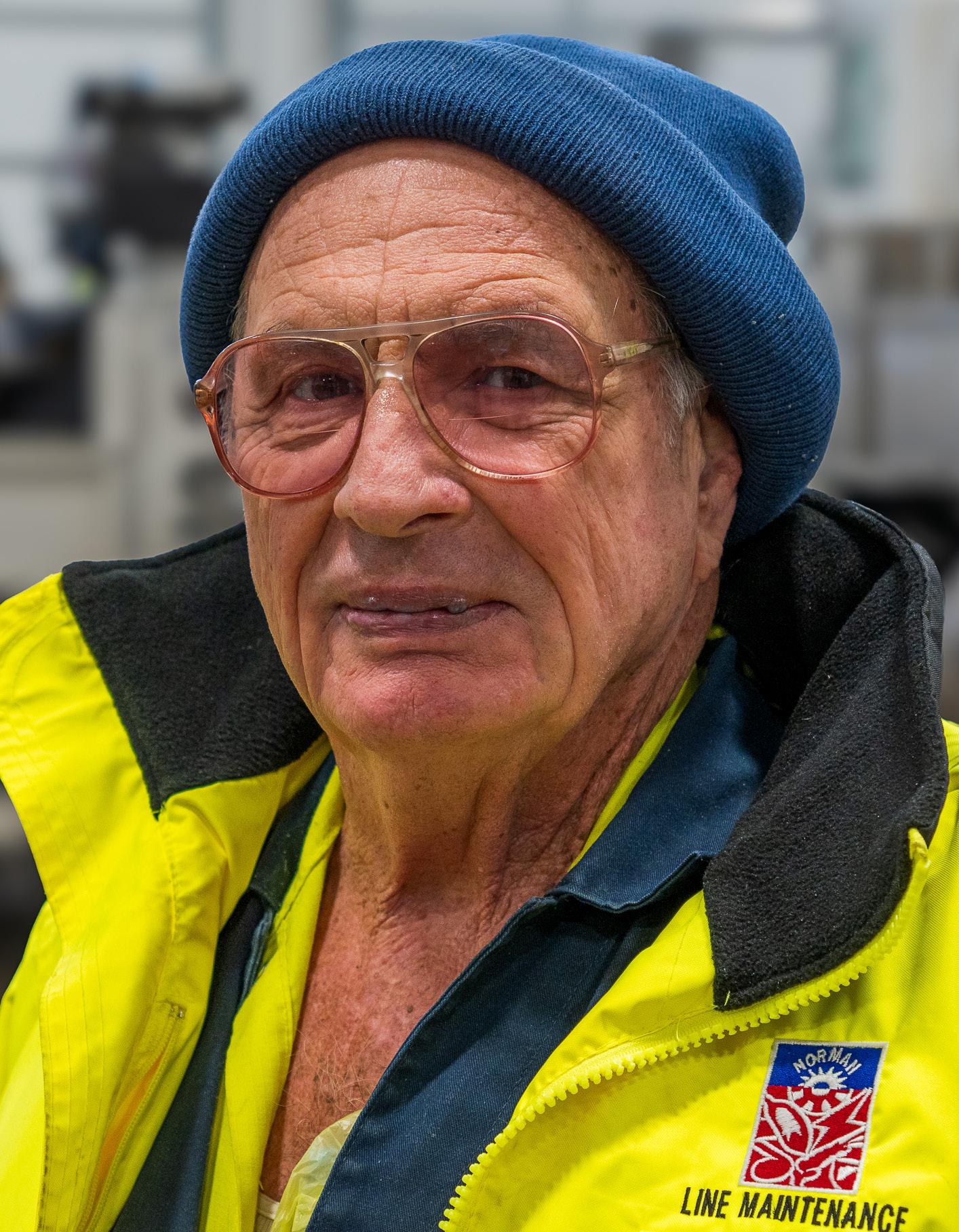
On April 11, 1962, Martin bought his first pickup, a new Chevy for $1950. He recalls a short wheelbase and short bed model were available for $1750.
He began his career in the Moore school system in 1973, where he worked for seven years. Martin has fond memories of the area.
“The area where Sooner Fashion Mall now stands was an alfalfa field and the mile of cars was a wheat field,” Martin said. “Lloyd Noble was under construction and Robinson was a narrow two-lane road.”
Both the region and Martin have experienced significant changes since then.
“It’s all changed, and I’ve changed some too,” he said.
Although he’s no longer jumping down into ditches to work on water mains, Martin takes calls and works on water meter problems in the City Water Division.
“I check on bills that are high, handle customer complaints and anything that has to do with water leaks,” he said.
Looking back over his long and admirable career, Martin said one of his co-workers likes to tell people he came to the department right after water was invented.
“We are so fortunate to live in this country and have this life,” Martin said. “Water is life. We have to have water. It is very important, and we need to conserve it and cherish it while living in our great country.” – BSM


